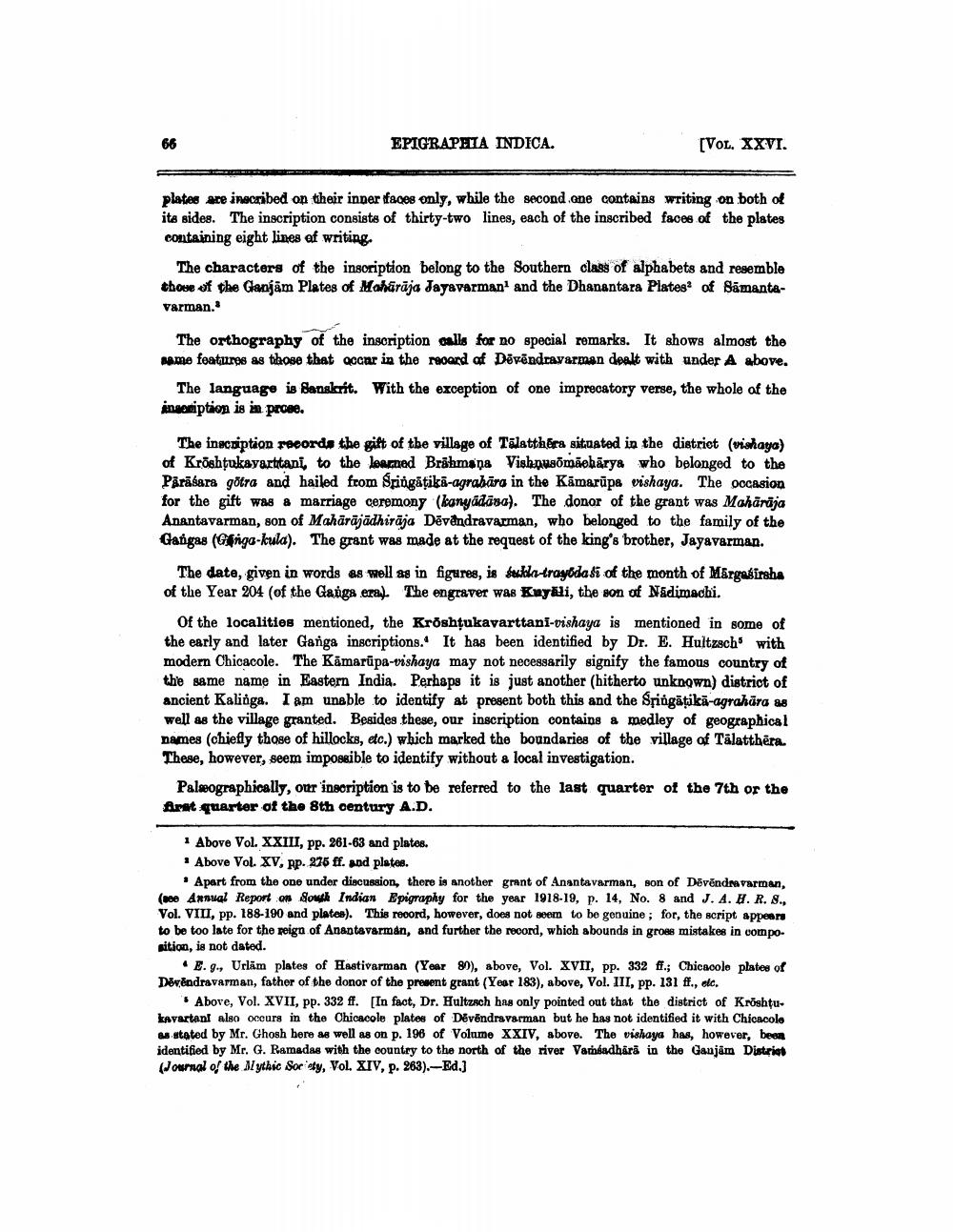________________
EPIGRAPHTA INDICA.
[VOL. XXVI.
plates are inscribed on their inner faces only, while the second one contains writing on both of its sides. The inscription consists of thirty-two lines, each of the inscribed faces of the plates containing eight lines of writing.
The characters of the inscription belong to the Southern class of alphabets and resemble those of the Ganjam Plates of Maharaja Jayavarman and the Dhanantara Plates of SamantaVarman.
The orthography of the inscription calls for no special remarks. It shows almost the Aame features as those that gocar in the roard of Dēvēndravarman dealt with under A above.
The language is Sanskrit. With the exception of one imprecatory verse, the whole of the ingeniption is in proee.
The inscription records the gift of the village of Talatthåra situated in the district (vishaya) of Kröshtukavarttani, to the learned Brāhmana Vishnusmãebärys who belonged to the Pārbara göra and hailed from Spiógátikā-agrahāra in the Kämarūpa vishaya. The occasion for the gift was a marriage ceremony (kanyadāsa). The donor of the grant was Mahārāja Anantavarman, son of Mahārājādhirāja Dēvendravarman, who belonged to the family of the Gangas (Ginga-kula). The grant was made at the request of the king's brother, Jayavarman.
The date, given in words as well as in figures, is sokka-trayodasi of the month of Margeirsha of the Year 204 (of the Ganga eral. The engraver was Kuykli, the son of Nádimachi.
of the localities mentioned, the Kröshtukavarttani-vishaya is mentioned in some of the early and later Ganga inscriptions. It has been identified by Dr. E. Hultzsch with modern Chicacole. The Kämarūpa-vishaya may not necessarily signify the famous country of the same name in Eastern India. Perhaps it is just another (hitherto unknown) district of ancient Kalinga. I am unable to identify at present both this and the Sriigātikā-agrahāra as well as the village granted. Besides these, our inscription contains a medley of geographical names (chiefly those of hillocks, etc.) which marked the boundaries of the village of Tälatthera These, however, seem impossible to identify without a local investigation.
Paleographically, our inscription is to be referred to the last quarter of the 7th or the Arst quarter of the 8th century A.D.
Above Vol. XXIII, pp. 261-63 and plates. * Above Vol. XV, pp. 276 ff. and plates.
Apart from the one under discussion, there is another grant of Anantavarman, son of Dēvēndravarman, (nee Annual Report on South Indian Epigraphy for the year 1918-19, p. 14, No. 8 and J. A. H. R. 8.. Vol. VIII, pp. 188-190 and plates). This record, however, does not seem to be genuine ; for, the script appears to be too late for the reign of Anantavarman, and further the record, which abounds in groes mistakes in composition, is not dated.
E. 9., Urlām plates of Hastivarman (Year 8), above, Vol. XVII, PP. 332 ff.; Chicacole plates of Devendravarman, father of the donor of the present grant (Year 183), above, Vol. III, pp. 131 ff., etc.
Above, Vol. XVII, pp. 332 ff. [In fact, Dr. Hultzach has only pointed out that the district of Kröshțukavartant also occurs in the Chicacole plates of Dévēndravarman but he has not identified it with Chicacole as stated by Mr. Ghosh here as well as on p. 196 of Volume XXIV, above. The vishaya has, however, been identified by Mr. G. Ramadas with the country to the north of the river Vatsadhara in the Ganjam District (Journal of the Mythic Soroty, Vol. XIV, p. 263).-Ed.)




